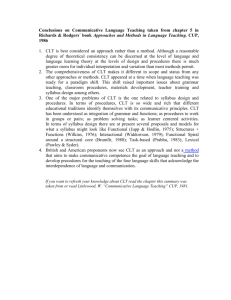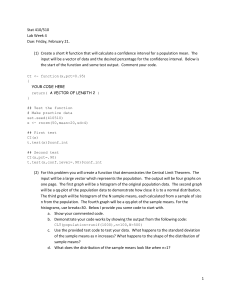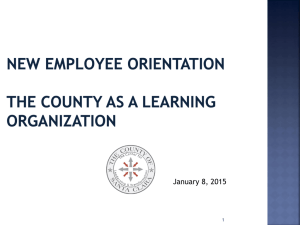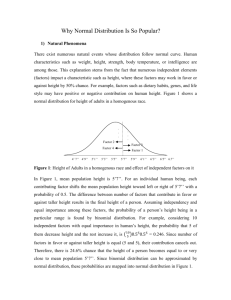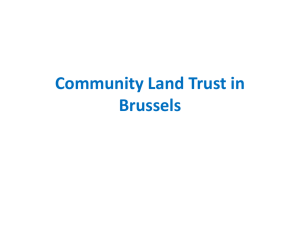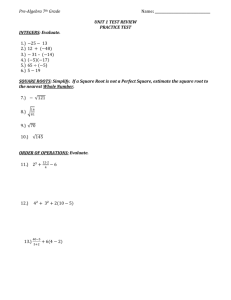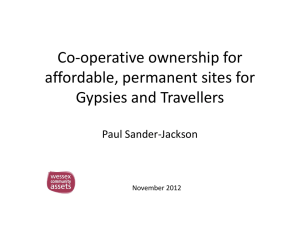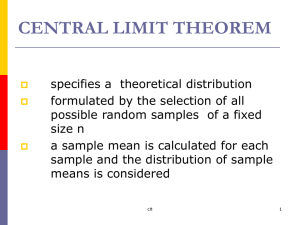docx - ODU Computer Science
advertisement
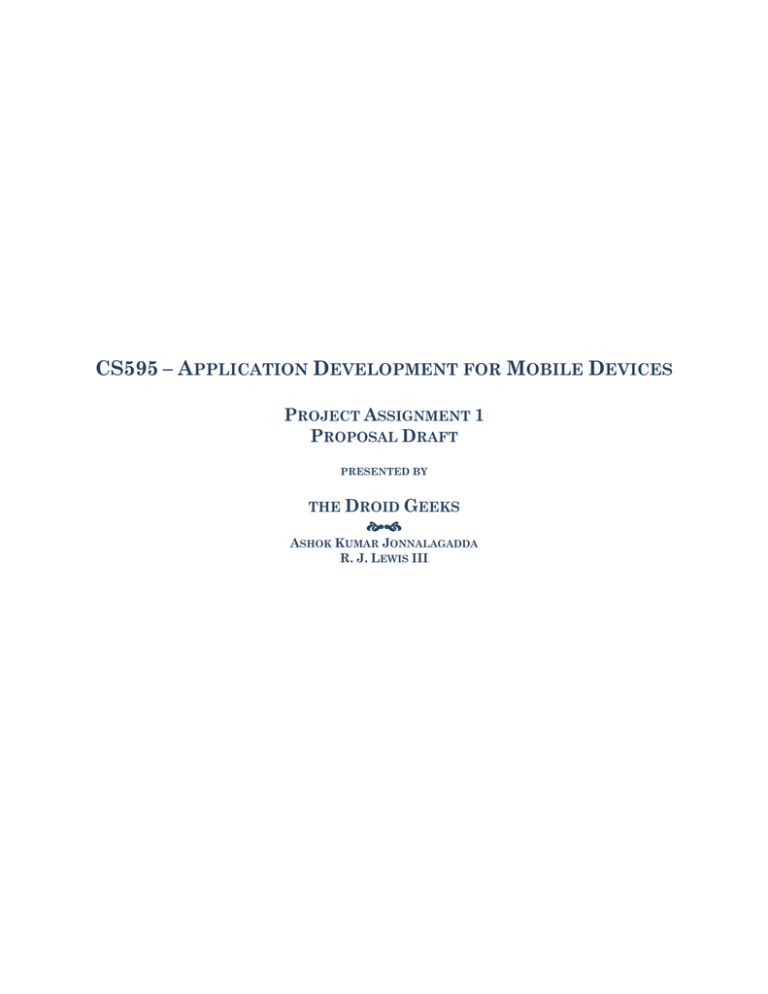
CS595 – APPLICATION DEVELOPMENT FOR MOBILE DEVICES PROJECT ASSIGNMENT 1 PROPOSAL DRAFT PRESENTED BY THE DROID GEEKS ASHOK KUMAR JONNALAGADDA R. J. LEWIS III OBJECTIVE Team Droid Geeks intends on assisting the Old Dominion University (ODU) Center for Learning and Technology (CLT) in achieving a long-desired goal. We will utilize our learned knowledge of the Android operating system in addition to our honed iOS development skills to achieve this end. Our intent is to build a collaborative, mobile-based application centered on the faculty and staff of ODU. The application will allow the audience to fully engage CLT tools and resources from a mobile platform. In doing so, we hope to aid the CLT in realizing their mission “to support, promote and enhance teaching, learning and research; and to foster innovation.” The mobile application we envision building will catapult the CLT program into the mobile-age and gives them a solid foundation on which to further develop their mobile-accessible package. MOTIVATION The CLT has expressed specific interest in having a product such as this. The CLT mission statement includes goals for the past academic year. Item number five directly calls out a their wishes for integration of mobile devices. The goal reads: “Share, research, evaluate, demonstrate, and integrate appropriate technologies such as: o Mobile devices (iPads, iPhones, etc.) o 3D environments o Social media applications” We have verbal confirmation that this same goal has been carried over into the present academic year and continues to be strongly desired. Our group, coupled with the first offering of this course, leaves us perfectly poised to assist CLT in realizing their goal. Ashok Jonnalagadda has intimate knowledge of CLT and brings a wealth of information to the team. He understands much of the desire CLT holds for their mobile application and he understands a good amount of the business logic employed by CLT. We feel this is an exciting opportunity to provide a very useful application to the faculty and staff community of Old Dominion University and one which, at first indirectly, benefits the students. More on this will be discussed below in the future development of our mobile application. On a personal note, we desire to create this application to further our development skills in both the iOS and Android markets. The university has also alluded to a reduction in tuition commensurate the true merit of our application. It will also be nice to know that we left something behind which can be further developed and benefited from; a legacy, so to speak. TASKS Our team has decided upon a specific breakdown of tasks. In the coming days, we will closer analyze the list of tasks in order to determine a specific order of implementation. Once this is done, we will better be able to identify key milestones in our development strategy. The tasks, in a non-finalized order, are: Native OS Integration o Synchronize CLT events with iOS/Android calendar o Engage mapping/navigation functionality to direct the user to a CLT event o Audio/video stream feed o Audio/video stream push (possibly limited by Android v2.2) Non-collaborative Features o List and filter CLT events (both mandatory and ancillary) o Pull full-text description and location for each event o List real-time attendance rosters o Enroll/dis-enroll as an event attendee (application will validate schedule conflicts) o Half-duplex audio/video CLT event stream Collaborative Features o Post and reply to messages within the CLT system o Full-duplex audio/video CLT event stream (possibly limited by Android v2.2) o Quick, simple integration to social media applications such as Twitter and Facebook We have, tentatively, assigned the high-level breakdown of these tasks to individual team members. Currently, Ashok Jonnalagadda will work on the non-collaborative features while R. J. Lewis will work on the collaborative features. Both members will work in tandem on the native OS integration tasks listed above. We don’t expect the audio/video streaming to be overly difficult, however, we’ve decided to work jointly on the native OS items to ensure proper implementation across both operating systems, given time to implement for iOS as well as Android. CHALLENGES We do not expect a great amount of issues in development. We have already established the hooks we’ll need to integrate a mobile service layer to CLT. Once those are implemented on the hosting systems for CLT, the mobile applications should be fairly straight forward. We do anticipate some difficulty with live streaming. We are not certain of our ability to tap into streams (if any) being delivered from a specific CLT event. This is something to be explored further with CLT and with the university. As such, this will most likely be our last-implemented feature. We have the ability to set up a server which can feed test audio and video. This is would not be as ideal as we would wish, however, it allows us to present a proof-of-concept which may be built upon in the future once further resources and authorizations are allocated. Time could present itself as an issue in cross-developing for both platforms. As prior discussed with the CS595 Application Development for Mobile Devices course instructor, Dr. Tamer Nadeem, initial implementation of this project will be completed for iOS. This aligns us with the wishes of CLT, however, we understand the popularity of Android and have determined that, given enough time, we will develop the same application for Android. TIMELINE The mock application for iOS will be ready by mid-November. This mock-up will implement most of the tasks listed above. By the end of the semester, it is anticipated that the audio/video streaming will be implemented. It is our sincere desire to develop each OS package to the same operational level by the close of the semester, but we must be pragmatic. We will, therefore, make ever attempt to implement each feature, except for the audio/video streaming, into the Android package by the end of the course. RELATED WORK The push into streaming and other live broadcasts to and from a mobile device seems like the most logical “next leap” for mobile technology. It appears that not much has yet been done to achieve such ends whether on the purely social side or the business side, as our application is geared towards. iVisit Presenter and iVisit Mobile by iVisit seem to have taken great strides towards this, but their applications and back-end are proprietary and are therefore not customizable by the organization which desires to implement the streaming solutions offered by iVisit. For organizations wishing to host their own content either for security purposes or simply for design freedom, the current iVisit products will not fit the bill. It will only be a matter of time until such a realization is determined and we hope to ensure ODU and its CLT are one of the first to push into this new frontier. FUTURE WORK In the not too distant future, we fully expect mobile devices to supplant students’ reliance on the devices we know as laptop computers today. The faculty and staff of a university are also a great part of this same academic environment and are truly ensconced in the same forward progression of technology. We see mature, mobile devices taking distance learning to an entirely new, and personal, level. Through the always-connected presence with which these devices operate and their ability to allow feedback and two-way communication (vice a push-only environment such as streaming video or audio), the sky is the limit in bringing everyone in contact with each other. As CLT builds and grows, we expect them to move much of their content into a mobile-accessible format. Ad hoc meetings, conferences and presentations can be routed, fully-duplexed, through voice and video channels of mobile devices and projectors and audio systems in lecture halls. Traditionally, the distributed learning model allows the audience to be abstracted from the presentation. With the devices of today and tomorrow, we’ll be able to abstract the presenter as well. There could be, in fact, no longer a need for a presentation hall or auditorium as the communication medium could completely exist within the ether of the global networked environment. We completely agree with the business model which CLT presents. If we are able to help them take the leap into the future of providing their presence on mobile devices, we see other distinguished universities and continuing education institutions following along with their own program. Better yet, ODU could conceptualize and package the CLT business model and provide it at cost to these other institutions.
